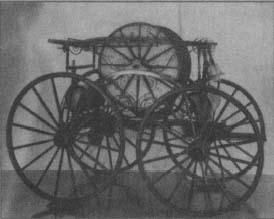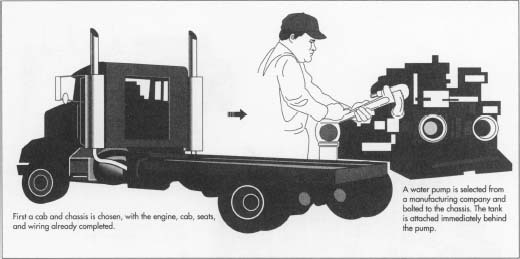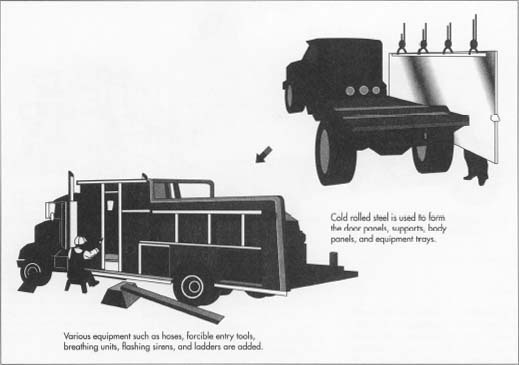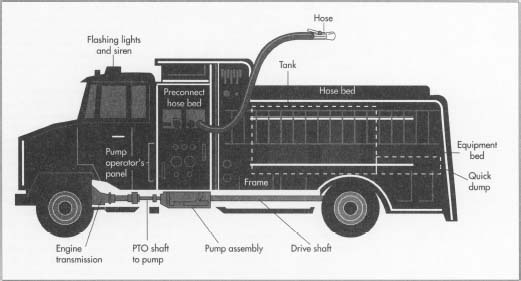Fire Engine
Background
The term "fire truck" is commonly used as a generic expression to describe a fire-fighting vehicle. Technically, a "fire truck" is a vehicle equipped with ladders and is used mainly to gain access to elevated portions of a structure or to provide a means of applying an elevated stream of water. "Fire engine" is a vehicle with a pump and is used primarily to pump water. A "fire wagon" carries large amounts of hose and is primarily used to lay hose as a complement to a pumper. "Fire apparatus" is the proper generic term for all of these vehicles. This entry will focus on the manufacture of a fire engine. From our first toys and books as toddlers to the everyday newscasts showing fire fighters in action, the fire apparatus remains one of the most familiar and impressive examples of technology in our lives. Uncontrolled fire was one of the greatest fears until quite recently. Early attempts to quell fires were merely bucket brigades, that is, lines of citizens handing water buckets to the fire, which was often ineffective against a fully involved building. Some attempts at increased water application were hand-operated piston pumps whose hoses pumped water from a holding tank or a pond. (These early hoses were made of leather with copper rivets; cotton hoses came into use in the 1800s.) Eventually wheels were added to the apparatus, but it was still pulled and operated by the firemen. Volunteer fire departments were established to man the equipment and fight the fire.
With the appearance of property insurance, insurance companies created fire departments and spent considerable time improving the fire apparatus. By the 1860s, the steam engine was used to operate the piston pump, and it was pulled to the fire by horses. Other attempts to pressurize the hoseline were chemical tanks, which used acid combined with soda dissolved in water to start a chemical reaction that would produce carbon dioxide. In this process, the carbon dioxide expanded, pressurizing the tank and propelling the entire mixture out of the hoseline and onto the fire. All of these designs were practically obsolete after the introduction of the centrifugal pump in early 1900. After the advance of the automobile, the internal combustion engine became the primary power source for the fire engine. Adaptation of the truck frame to accommodate the pump and tank completed the transition to the presentday fire truck apparatus.
Design
The basic design of the fire apparatus begins with a thorough review of the fire load and geographical terrain of the area the fire department will be responding to. The vehicle's ease of operation, adequate response speed, and equipment storage and deployment are all important factors to consider. The National Fire Protection Association (NFPA) has compiled guidelines for apparatus design based upon these and other variables. In addition, the fire fighters responsible for the apparatus also contribute to the design of the vehicle.
Most fire apparatuses are purchased by tax-supported governments, cities, towns, townships, and counties. In small departments, the design and approval process can take up to a year, mainly because of funding issues. When medium and large departments choose a new apparatus, funding is usually already established, and designs can be approved and purchased in less time. A fire engine can cost from $50,000 to over $750,000.
The basic fire apparatus has evolved into specialized units for particular types of fires and response. In the 1950s, pumpers, ladder trucks, and other miscellaneous designs such as small tankers and hose trucks were common, though airport crash trucks and large rural tanker trucks were also in use. Today, fire apparatuses are tailored to meet many kinds of specific hazards. Due to this wide variety, the rest of this article will discuss the manufacture of the basic combination pumper apparatus for small- and medium-size communities.
The Manufacturing
Process
The manufacture of a fire engine remains a custom, almost one-of-a-kind operation. Typically, a group of workers is assigned to the fabrication of the body and assembly of the truck frame. A separate group performs body finishing, then the apparatus is wired, equipped, and tested by a third, or "equipment," group. Aside from the body, manufacture of the fire apparatus is typically an assembly process.

Fire was a plague in many early American cities. Americans responded with a variety of weapons: volunteer fire department's; inventions that prevented,, retarded., or fought fire; and insurance cooperatives ond plans that protected against losses caused by fire. Through the early and mid decades of the 1°fh century, a major fire was a calamity but also a social affair.
A city's volunteer fire companies often illustrated the city's social, ethnic, and demographic composition. Fire companies represented the ioyalty and corwaderies of special groups. Neighborhood pride, political rivalries, ethnic hostility, and class animosity were alt evident in the volunteer fire companies. Companies received public acclaim for their efforts and competed wiih one another for those public accolades. Af the first signal of a fire, companies would race to the scene pulling their hose carts and handpumped engines—not necessarily to catch the fire in its early stages. The commander of the first company to arrive would be in charge of the entire operation with absolute control over rival companies. Members fought with one another on the way and at the site, sometimes forgetting even to fight the fire! Once at the scene, more fighting could occur and volunteers were threatened as much by other firefighters as they were by the fire itself.
Members took great pride in their uniforms and equipment because these represented the group's social status as much as they did its fire-fighting competence. Equipment and uniforms were dtspfayed during public ceremonies and parades where competition for social status was particularly evident in pre-Civil War America. Hose carts and engine! were display pieces os well as functional equipment.
William S. Pretzer
Chassis
- 1 The selection and purchase of the truck chassis is based upon the tactical application of the apparatus. The truck frame may be "bare," having only the engine, axles, springs, frame members, steering, and brake systems installed. The apparatus builder may choose, however, to use a "cab and chassis," where the frame has the engine, cab, seats, front sheet metal, and wiring already completed. In either case, the truck frame is usually ordered from a well-established truck builder such as General Motors, Ford, International, Freightliner, or Peterbilt. The apparatus builder advises the truck manufacturer of the intended design so special options concerning the performance of the frame can be made. It is critical that the proper selection of suspension be made to support the average 35,000-pound (15,890 kg) fire engine. In our example, we have chosen the cab and chassis frame design.

Body
- 2 After the truck frame is received and inspected, the fabrication of the body (or "coach," as it is sometimes called) begins. Primarily sheet steel is used for body panels and supports, although aluminum and some stainless steel are also incorporated. Sheet steel is approximately 0.06 inch (1.5 mm) thick and comes in sheets 48 inches (1.2 m) and 96 inches (2.4 m) long. It can also be supplied in rolls of the same width and weighing 2,000 pounds (908 kg) or more. Each door panel, support, body panel, and equipment tray is cut and bent using shearing machines and press brakes. Holes for electrical equipment and piping are also punched at this time. The body is typically metal inert gas (Mig) welded together, with the doors and access panels bolted for ease of replacement. Many manufacturers protect the body from corrosion by dipping each panel into a rust inhibiting sealer. The interior and other hidden areas of the doors and cabinets are pre-painted before assembly. While the body construction is underway, the pump and tank are mounted to the frame.
Pump
- 3 The pump is selected to perform specifically for the practices of the fire department. Essentially, the pump is the only reason for the fire engine. All of the other features are practically useless if the pump does not perform adequately. Most firepumps today are centrifugal pumps, and are manufactured by separate companies and purchased by the apparatus builder. A typical firepump can pump 1,000 gallons (3,785 1) of water per minute. This flow can safely provide enough water to fight a residential or small commercial building fire. Pump size can be restricted by the available water supply, particularly in rural areas where there are no fire hydrants. Pumps are usually cast iron, with bronze for the rotating impeller and steel gears in the drive unit. Our truck shall have the 1,000 gallon per minute pump bolted to the frame near the center, and driven by an auxiliary output shaft (or "power take off") from the truck transmission. This type of arrangement is referred to as a "midship" pump apparatus. The pump sits across the frame of the truck, and is bolted through the support castings to the upper frame flange. Alignment with the transmission is important to reduce vibration.
Tank
-
4 The water tank for this example apparatus would typically be a
polypropylene tank holding 500-1,000 gallons (1,892-3,785 1) of water.
This is bolted to special
supports before being attached to the frame immediately behind the pump. Connective piping to the pump and filling openings is also installed, typically of galvanized steel construction. Tanks may be square, round, or oval, and many are "hot-welded" together out of sheet material. The hot-welding process uses a high temperature stream of air to melt the plastic pieces at their joint, where the material mixes and fuses together. Most tanks contain perforated plates or "baffles" to reduce the sloshing of the water while driving.

Occasionally, a "quick dump" is installed in the tank of an apparatus designed for use in rural locations. This large valve "dumps" the water from the main tank into a folding portable tank, carried to the fire on a separate tanker truck. This allows the tanker trucks to shuttle water from long distances and empty into the portable tank, where large suction hoses feeding directly into the pump allow the flow to be increased to maximum capacity. These quick dump valves empty the 1,500 gallons (5,677 1) of water in 45 seconds.
Assembly
-
5 When the body is completed, it is mounted to the frame over the pump
and tank, and bolted using neoprene or rubber vibration strips. Along
each side and above the tank are the equipment and hose compartments.
They are formed into the body with doors and covers for protection.
Related equipment, such as hose nozzles, as well as tactical equipment,
such as forcible entry tools and self-contained breathing units, are
stored in the side equipment compartments. They are sized and equipped
to allow the fastest and easiest deployment of the equipment.
The hose beds carry the fire hose. The top bed usually contains 50 foot (15 m) long 2.5 inch (76 cm) diameter sections of fire
hose, connected together to form hoselines reaching up to 1,000 feet (305 m). This hose is folded in such a manner as to allow it to be pulled from its bed with ease and speed. Shorter sections of suction hoses are also carried on the apparatus. These suction hoses are made of a firm material so they do not collapse from the reduced pressure when coupled to the suction of the pump. They cannot be folded, so they are usually placed into hose troughs specially designed for suction hoses. All other types of fire hoses are collapsible and for use on the pressure side of the pump only. After the last accessories and wirings are installed and individually tested, the apparatus builder submits the finished truck to an independent inspection agency. Upon successful testing, the apparatus and the builder are awarded a certificate of performance.
After the last accessories and wirings are installed and individually tested, the apparatus builder submits the finished truck to an independent inspection agency. Upon successful testing, the apparatus and the builder are awarded a certificate of performance.In front of the tank, and above the pump, are the attack hoseline beds. These beds contain 1.5 inch (3.8 cm) diameter firehoses preconnected to the output of the pump with the nozzles ready for action. Two or four beds of "preconnects" are common. These will be the first hoses used in the incident, therefore they are the most important. Behind the tank is the reel booster. Here, a one-inch (2.5 cm) diameter hose on a power roll-up reel is stored. This booster hose is used for cleaning the apparatus and equipment, and for cooling the outside of the apparatus when it is near a large fire. It is also occasionally used to put out small trash or grass fires. This reel is handy because the hose can be quickly rewound by simply pressing a button. All other hoses on the fire truck must be washed and packed back into their beds by hand after the fire incident.
Ladders for the fire service are extra heavy duty. Though made out of aluminum, they are physically heavy, so they are typically carried in racks above the curb-side (right side) equipment compartments. Power racks have been developed to lower the ladder to waist height, but most commonly the fire fighters simply lift the ladder off of the rack and proceed to the fire. Ladders, like pumps, are also purchased from other suppliers and installed by the apparatus builder.
Painting
- 6 Once the body has been assembled to the truck frame, the equipment mounting holes are located and drilled, and any additional holes or passages are cut into the panels. This allows the painting operation to seal the exposed edges of holes and other openings. The exterior of the apparatus is washed and sanded in preparation for painting. The interior of the doors and compartments have already been painted. The out-side can be painted in matching colors. The painting process includes a primer surfacer to fill small sanding marks and surface defects and a sealer to improve paint adhesion. Fire trucks used to be all red, but some experiments with yellow, blue, and white have been done to increase visual identification. Today, the NFPA recommends yellow or the standard Fire Engine Red. The type of paint is usually a tough enamel or synthetic to resist burning embers and wear from fire service. Hardening agents are added to the paint to improve the shine and durability. After painting, the ladders and accessories can be installed using stainless steel fasteners.
Installing wires
- 7 The modern fire apparatus can be complicated. Radio systems, cellular phones, computers, and cellular fax machines are all finding their way into the fire service. Even our example apparatus will require several hundred feet of wiring to operate the warning lights, siren, radios, bay lights, generator, flood lights, pump electricals, and other systems. Most apparatuses have two independent battery systems, which must be wired into the apparatus after painting. The pump operator's control panel, containing the pressure gauges and valves used to control the pump, will also be installed.
Quality Control
After the last accessories are installed and individually tested, the apparatus builder submits the finished truck to an independent inspection agency. The agency takes delivery of the truck equipped just as it would be placed into service. It operates and inspects all of the apparatus systems. The pump is operated at maximum capacity for two hours to assure that this vital component performs properly. Upon successful completion, the apparatus and the builder are awarded a certificate of performance. In many areas, the apparatus cannot be legally delivered without this certificate.
The Future
Many new technologies are being applied to the modern fire apparatus. New tank materials are increasing in strength while reducing weight, allowing for more water capacity. Some large departments are using computers and cellular communications to handle information about hazardous materials, structure design, and geographics of the fire district. Perhaups the most exciting of the new technologies in the fire apparatus is the increased use of Class A foam solutions to attack structure and vegetation fires. This involves a separate on-board foam concentrate tank and a mixing proportioner to combine the foam concentrate with the water in the proper amount. Class A foam coats burning surfaces and absorbs heat significantly better than water. When used with compressed air from a separate air compressor on the vehicle, this technology is known as a Compressed Air Foam System, or CAFS. The compressed air pushes the water/foam stream to a much greater distance, and the resulting foam clings like shaving cream. In addition to these advances, firefighters are becoming better trained and are customizing their equipment to fit the types of fires they encounter.
Where To Learn More
Books
Buff, Sheila. Fire Engines: Motorized Apparatus Since 1900. Longmeadow Press, 1994.
Fire Protection Handbook, 17th Ed., 1991. National Fire Protection Association, Quincy, Mass.
Periodicals
Cottet, Jack L. "Enclosed Cabs for Fire Apparatus." Fire Engineering, October 1990, p. 50-52.
"Agile Fire Engine Borrows from Racing Car Design." Engineering, September 1990.
— Douglas E. Betts
Comment about this article, ask questions, or add new information about this topic: